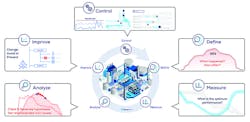Companies in a variety of industries, and especially those in the chemical industry, understand that digitalization is required to remain a market leader and sustain future profitability. On the wave of digitalization within the era of Industry 4.0, advanced analytics has been the realm of data scientists. But because there are not enough data scientists to be found in the market, advanced analytics needs to be democratized. Many companies have made the first strides on this journey, while others are already further down the path. On their journey, valuable lessons were learned, but the leaders of those organizations were also looking for business insights they could gain from applied analytics, machine learning and artificial intelligence (AI). It’s about aligning the business objectives with direct business outcomes across departments, all while growing the production knowledge. This is especially true for specialty chemicals, where batches are becoming smaller and more diverse to meet customer demand.
Jumping on the analytics bandwagon
To take the next steps toward optimizing process and asset performances, many process manufacturing companies are already performing data analytics to some extent. The objective is to have zero surprises and no unplanned downtime. Luckily, the process manufacturing industry is the proud owner of most of the existing data points in the world, even surpassing Amazon and Google. This same industry, however, hovers toward the bottom when it comes to translating these data points into actual information.
The process manufacturing industry is experiencing a number of crucial data analytics challenges:
- Improper tools
- Insufficient analytics knowledge
- Insufficient embedding of analytics in work processes
- Unclear economic benefits
- Insufficient management support
As a result, engineers spent the majority of their time stretching the limits of Microsoft Excel trying to acquire and prepare data and visualize the problem, instead of actually analyzing the problem and gaining crucial insights from it. Secondly, when it comes to problem solving, the "language" barrier between subject matter experts and data scientists is too big. Training process engineers to become data scientists is too time-consuming and inefficient, while hiring additional data scientists is too costly and risky. So, the question remains: how do you put critical analytical skills and capabilities into the hands of the process and control engineers, enabling them to solve problems on their own and passing the more complicated issues on to the data scientists?
Figure 1. ARLANXEO use cases: What can production analytics deliver?
Proven value encourages a continued journey
Instead of juggling spreadsheets and limiting themselves to the trend client of historians, engineers can work with advanced analytics solutions without being trained as a data scientist. We call this self-service advanced analytics, where the statistical methods of data scientists, machine learning and AI are all applied. The users have a visual interface, showing the time-series data in a recognizable format so they can use their subject matter expertise for finding ways to improve process performance and even predict required maintenance.
Implementing self-service industrial analytics can enable engineers to get more robust and faster insights into their operational production data. It enables them to identify new areas for performance optimization with advanced root cause analysis capabilities. It also allows them to monitor production to avoid abnormal situations and even predict future evolutions of batch runs, transitions or equipment startups in minutes. It enables the business users, such as process and asset engineers to:
- Solve previously unsolved process performance issues
- Verify hypothesis and prove them to be either true or false, so they can be addressed or ruled out for the future
- Find new ways to improve production performance, because data with captured events and early warnings provide new insights
- Use contextual information from third-party business applications to gain new insights into operational performance
- Use actionable dashboards to monitor operational performance in real-time
Customer success story 1:
ARLANXEO is a chemical company developing, manufacturing and marketing synthetic high-performance rubber for use in various industries. ARLANXEO decided to gradually roll out the use of self-service industrial analytics over its sites after a successful pilot implementation at one site.
During the pilot, one of the cases was related to valve leaks. Engineers wanted to use self-service industrial analytics to find the root cause for valve leaks in a regeneration process of a dryer used to remove water from MeCl (methylene chloride). These leaks cause huge losses of the expensive MeCl, and spillage causes severe corrosion in expensive assets in the regeneration circuit.
By using the easy search capabilities of the self-service analytics platform, the engineers could easily find the regeneration cycles. By creating a "fingerprint" of normal flare behavior during regeneration, they could monitor operational performance, and after finding the root cause, they can create early warnings to avoid valve leaks and schedule maintenance. The quick detection of the valve leaks significantly reduced the corrosion in the regeneration circuit and the reduction in MeCl flaring had direct impact on the cost reduction while it also mitigated environmental and safety hazards.
The various use cases (see Figure 1) during initial roll out helped ARLANXEO understand what benefits self-service industrial analytics could bring. ARLANXEO was able to:
- Increase the quality of its analyses by using more comprehensive sets of data
- Get easy access to historical data
- Gain complex process insights by analyzing a broader set of parameters across multiple steps in the process
- Integrate root cause analysis and process monitoring to define future alerts, and start looking for similarities and optimize processes
- Compare various scenarios to statistically find out the performance parameters to meet the best product quality
Customer success story 2:
Sitech provides maintenance, technological improvements and advanced process control to help industrial companies at Chemelot (an industrial complex in The Netherlands) maintain its competitive edge. DSM, Borealis, ARLANXEO, Sabic and many others can count on Sitech’s latest technological applications, the right expertise, the best innovations and far-reaching digitalization.
One of the cases Sitech worked on was the Haber-Bosch process. The Haber-Bosch nitrogen-fixation reaction has been used for more than 100 years to make ammonia and other nitrogen-containing compounds from nitrogen and hydrogen.
Although perceived as a fully optimized production process, carbon dioxide peaks were found in the washing column. Previous data analysis projects failed to find the root cause, but its chosen self-service industrial analytics software helped Sitech to search and compare peak periods with normal operation periods. Also, the team performed a layer comparison, which helped identify which processes influenced the variables.
With help of these findings, Sitech was able to realize a stable operation, which resulted in increased production, with a 5% revenue increase — representing $2.4 million in the first year — as a result.
Figure 2. Continuous Imrprovement
Lessons learned — avoiding the pitfalls
The benefits of self-service analytics have been clear for ARLANXEO, Sitech and many other industry leaders. It enables their teams to analyze issues that are too complex using conventional tools and helps them gain faster insight into process issues. It enforces alternative thinking and a new way of looking at their operational performance by using data.
But, adapting to new software often asks for an organizational shift — a new way of looking at technology and data. To prevent process engineers from falling back on traditional ways of working — the well-known Double S curve of innovation — a champion is required: a subject matter expert who is experienced with the new software, helping the users to solve cases, experience successes and shorten the learning curve.
The tools are available, all that is needed is visionary management that eases the change in business processes and the mindset of the business users. From hundreds of use cases among the most successful digitalization journeys, it comes down to these five key lessons learned:
- Identify clear goals, tied to a long-term vision
- Start small to grow fast
- Identify the right key users
- Communicate progress from start to end
- Work toward quantified results
- Continuously improving operational excellence
In particular regarding lesson No. 5, "Work toward quantified results," business objectives need to be set first and key performance indicators (KPIs) set on each level of the organization — starting from upper management, to plant, to department and all the way to the operators and engineers. With the aligned KPIs, this creates a backbone to analyze, improve and benchmark globally, as well as locally. On the other hand, the set KPIs can be achieved when the process experts are empowered with advanced analytics to fuel the increase of overall profitability and sustainability.
When engineers start using a systematic, analytics-driven approach, such as the DMAIC cycle (see Figure 2), a business environment is created of continuously improving operational excellence, where the large group of operational experts contribute to the business objectives and can even help over-achieve the targets.
Breaking down the data silos
Factories today are capturing and storing an enormous amount of data directly or indirectly related to the production process. All this captured data typically ends up in best of breed business applications serving specific operational purposes. Some of the data is stored in historians. Other data goes into the quality information system, maintenance management system, incident management system, etc. Self-service analytics of time-series data already sheds light on the operational performance. But having all the available contextual information available, captured during production and leveraged from other applications, there is much better visibility into operations. All this contextual information helps to better understand operational performance and give new starting points for optimization projects when using an advanced analytics platform.
Controlling business outcomes with an analytics-driven ‘production cockpit’
Ideally, all operational stakeholders would have what we refer to as a "production cockpit," which is complete with an actionable dashboard, analytics suite and agile communications facility. Users at each level of the organization can create and share complete and live overviews of their current process statuses and performances, enabling teams and individuals to immediately access production data, analyze situations at hand and make decisions in an instant.
Enhancing the current process status overview with the early warning capabilities that self-service analytics solutions provide, the "production cockpit" can provide operators the opportunity to be proactive and optimize operational performances even before issues arise. It also helps optimize the flow of information between shifts, from shift teams to engineers and between all related actors and production stakeholders, thereby boosting the organization’s collaborative agility. These are just a few of the ways that self-service industrial analytics is able to cater to the needs of engineers today, while business outcomes are directly controlled and communication between departments is optimized.
Conclusion
When all business users are empowered with self-service advanced analytics, process manufacturing companies have the best change to remain a market leader and sustain future profitability. Subject matter experts have a good understanding of the data that is directly related to the production processes they are responsible for, and are able to turn this into operational information. Today, this information can be provided in an analytics-driven production cockpit with live data and early warnings, resulting in a business environment of continuous improvement. In this way all users at each level in the organization can proactively contribute to business outcomes in areas such as energy reduction, waste reduction, quality control, yield and predictive maintenance.
Edwin van Dijk is VP of Marketing at TrendMiner.


